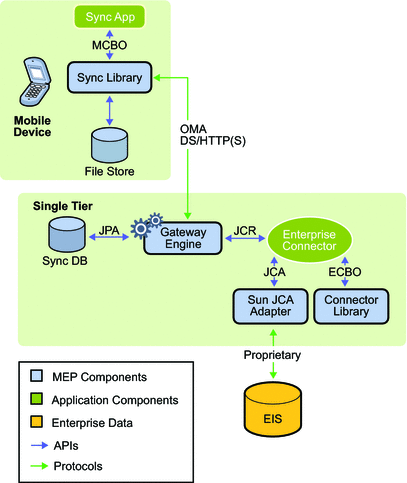MEP Architecture
MEP supports synchronization of enterprise data between Open Mobile Alliance Data Synchronization (OMA DS) enabled mobile phones and a database or EIS/EAI system.
The MEP architecture is based entirely on open industry standards and is designed to operate a highly scalable, fault-tolerant environment tightly integrated with the existing infrastructure. MEP includes support for automatic failover and load-balancing, providing near-linear scalability. This architecture has been proven in carrier-grade deployments.
The major highlights of the MEP architecture are as follows.
- Mobile Client Business Object API
-
The Mobile Client Business Object (MCBO) API provides an easy-to-use programming interface. It is provided as a Java ME library that the client application developer can use to develop a MEP Client application.
See Sun Java System Mobile Enterprise Platform 1.0 Developer’s Guide for Client Applications for information about using the MCBO API.
- MEP Gateway
-
The MEP Gateway is the server component that interprets the incoming OMA DS messages and translates them into commands and data for Enterprise Connectors. The interface between the Gateway and the Enterprise Connectors is the Java Content Repository API.
- Sync Database
-
The sync database contains the tables required by the MEP Gateway to store synchronization timestamps for client devices, mappings between client and server items, user information, configuration information, and synchronization message digest data.
- Enterprise Connector Business Object API
-
The Enterprise Connector Business Object (ECBO) API provides an easy-to-use programming interface that makes it easy to build Enterprise Connectors.
See Sun Java System Mobile Enterprise Platform 1.0 Developer’s Guide for Enterprise Connectors for information about using the ECBO API.
- Sun JCA Adapters
-
Sun JCA Adapters are Java EE Connector Architecture-based resource adapters that read and write data in the native format of specific databases or EIS/EAI systems. MEP includes adapters for SAP ERP, Siebel EAI, JDBC, and Oracle.
Figure 1–3 illustrates a single-tier MEP architecture. The client Sync App uses the APIs in the client library to communicate with the Gateway Engine, Enterprise Connector, and the Sun JCA Adapter. The adapter communicates with the EIS/EAI system.
Figure 1–3 Single-Tier MEP Architecture

Figure 1–4 shows a two-tier architecture, consisting of a Gateway tier and an Enterprise tier. The Gateway tier includes the Gateway Engine and Web Service connector. The Enterprise tier includes the Web Service endpoint and Enterprise Connector, as well as the Sun JCA Adapter that communicates with the EIS/EAI system. The Web Service connector in the Gateway tier uses SOAP over HTTPS (or HTTP) to communicate with the Web Service endpoint in the Enterprise tier. The Enterprise Connector uses the ECBO APIs to communicate with the Connector Library and the JCA APIs to communicate with the Sun JCA adapter which, in turn, communicates with the EIS/EAI system.
Figure 1–4 Two-Tier MEP Architecture

- © 2010, Oracle Corporation and/or its affiliates
